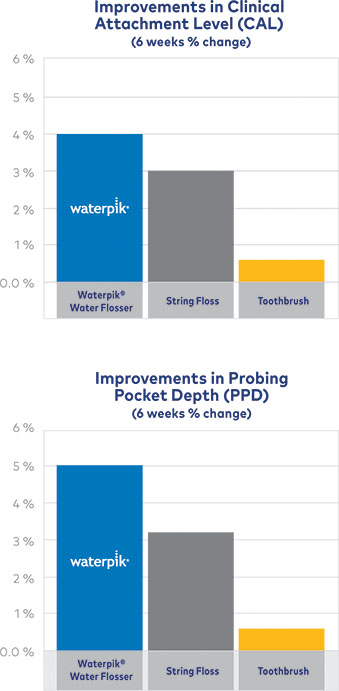:: ParamList ::
exec oc.GetBlogInfo
@DomainName = '.com' ,
@Language = 'en-US' ,
@BusinessUnit = 'OP' ,
@BlogCategory = '__ALL__' ,
@BlogType = 'Research' ,
@BlogURL = 'waterpik-water-flosser-safe-and-effective-goyal-lyle-2018' ,
@Brand = '__ALL__' ,
WaterpikTM Water Flosser: Safe and Effective up to 100 psi
Evaluation of Water Flosser Safety at High Pressure Settings
Objective
To evaluate water flosser safety on gingival and epithelial tissue at high pressure settings.
Methodology
One hundred and five subjects were randomly assigned to one of three treatment groups in this six week, parallel clinical trial: WaterpikTM water flosser plus manual toothbrush (WF), string floss plus manual toothbrush (SF), manual toothbrush only (MT). Data was collected on six designated teeth at baseline, two weeks, four weeks, and six weeks for clinical attachment level (CAL), probing pocket depth (PPD) and oral soft tissue (OST). For CAL and PPD data was recorded at six sites per tooth. Subjects were instructed to brush twice a day with the toothbrush and tooth paste provided. Written and verbal instructions were given for the WF and SF groups. The WF group changed pressure settings as instructed: #4 – 8 for two weeks, #9 for two weeks and #10 for two weeks.
Results
No adverse effects were reported. The WaterpikTM water flosser exhibited stability in clinical attachment level and probing pocket depths. The results compared favorably to string floss or manual brushing alone, demonstrating it is comparable, and in some sites, better than the SF and MT groups. No negative impact to Oral Soft Tissue occurred.
Conclusion
This study removes any concerns that the WaterpikTM water flosser, regardless of pressure, is associated with a negative impact on the gingival tissue or epithelial attachment as measured by CAL and PPD. In fact, CAL and PPD improvements were observed for the water flossing group.
